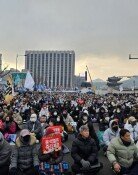[Opinion] I Wish to See Calm and Elegant Scene of Kyungbok Palace
[Opinion] I Wish to See Calm and Elegant Scene of Kyungbok Palace
Posted November. 22, 2001 09:22,
Gingko trees standing along the walls of Kyungbok Palace have already shed lots of their leaves. Now the season of `fallen leaves` is ready to hand its place over to the winter. By the way, I had marveled at the golden radiance of gingko leaves over past several years, but this year`s leaves did not look as beautiful as those of the past, but their color seemed to have faded away. Not only I, but also many others shared the same sentiment.
It is well known that Kwanghwa-Moon is the most polluted place in terms of air. The reason is that Kwanghwa-Moon is one of the places where bus routes are concentrated the most. Since it is the center of Seoul metropolis holding over a 10 million population, such a reality seems to be well endured. Kyungbok Palace is located nearby the Kwanghwa-Mun intersection. The Chosun Dynasty built up the main palace right here because it was a propitious site surrounded by the Left Blue Dragon Nak Mountain, the Right White Tiger Inwang Mountain, Bukhan Mountain and Han River. Such a propitious site of Kyungbok Palace and its surroundings are suffering from pollution.
To make matters worse, the inner and the outer spaces of Kyungbok Palace have been crowded with big tourist buses and cars carrying visitors since the early months of last year.
Especially, cars occupy one traffic lane outside the walls as if it were a parking space, covering up the walls of the archaic palace during weekends. Since those cars keep their engines running, air pollution around this place is increasing. This is a reason why gingko trees along the walls of Kyungbok Palace have become so. Is it that only gingko trees are suffering? It cannot be said enough about how much the residents are suffering.
The situation as such can be attributed to the opening of the foreground of Cheong Wa Dae and a huge success of the Folk Museum located inside Kyungbok Palace. They deserve a welcome and a celebration, but unexpected things have occurred. As the success of tourist attractions has brought in an environmental damage, so Kyungbok Palace and its surroundings have turned into places suffering from air pollution and fussing noises. Even a suggestion has been made that the street around Kyungbok Palace be designated as people`s street or `street of cultural entertainment`. Such might have been the case when an urban planning specialist once attempted to convert the street into so thronged a street as Insa-Dong last fall.
Isn`t it natural and humanistic that Seoul having 600 year-old history is comprised of such busy market places as Dongdae-Mun and Namdae-Mun, vital fashion streets and night-life of Myung-Dong, antique shops of Insa-Dong, modern art galleries, public theaters, peaceful resident areas and apartment complexes, archaic palaces and roads along their walls where people can feel history and contemplate, and college streets surrounded by intellectual and serene atmosphere? Then, why is Seoul turning into a disorderly and disgraced city?
Recently, a way to solve the parking problems around Kyungbok Palace to some extent has appeared, that is, there is news that a plan to transfer the Folk Museum located inside Kyungbok Palace is on the way. The Folk Museum has grown to the most visited museum in less than 10 years since it was separated from the National Museum. It has already gone far beyond the controls of the current size and human power. The plan to transfer the Folk Museum is expected to be pushed forward as its own necessity is in gear with the restoration of Kyungbok Palace.
But there still remains a problem. As weekend leisure activities become popular, families and groups will become more active in visiting cultural sites, and thus, the current capacity of parking spaces provided by Kyungbok Palace and National Central Museum inside it will be unable to meet the demands. Furthermore, the scene that big buses are parking in the foreground of the palace damages the beauty and the environment of the palace seriously.
One solution is that Kyungbok Palace and the museum should disperse visitors by employing a reservation system for a group visiting. And Seoul City and Chongro-Gu should remodel the underground parking lots located between the Sejoing Cultural Center and Central Government Complex into those capable of holding big buses, and maximize the convenience for visitors by making an underground route towards the inside of Kyungbok Palace (the side of subway exit). This is a costly work but not impossible if modern construction techniques are employed.
Don`t you think that motor vehicles should be prevented from parking inside and outside Kyungbok Palace? Don`t you think that there should remain one or two quiet places in Seoul? Thus, I wish that Kyungbok Palace and its surroundings can recover their calm and archaic character and dignified history. I wish that the gingko trees along the old palace can recover their health so as to hold a fall festival with the radiance of golden leaves.
Kim Hong-Nam (Professor at Ewha Women`s University, Art History)
Headline News
- Joint investigation headquarters asks Yoon to appear at the investigation office
- KDIC colonel: Cable ties and hoods to control NEC staff were prepared
- Results of real estate development diverged by accessibility to Gangnam
- New budget proposal reflecting Trump’s demand rejected
- Son Heung-min scores winning corner kick







